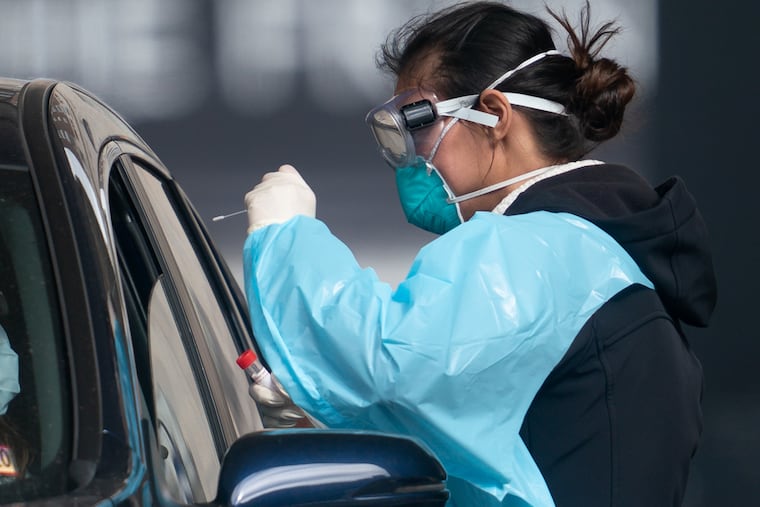Black, Hispanic women infected with coronavirus 5 times as often as whites in Philly, Penn study suggests
That stark disparity — far wider than what has been reported in the general population — was among the latest COVID-19 research presented Wednesday by Penn’s Perelman School of Medicine.

Black and Hispanic pregnant women in Philadelphia tested positive for antibodies to the coronavirus five times as often as their white counterparts in April and May, a University of Pennsylvania study has found.
That stark disparity — far wider than what has been reported in the general population — was among the latest COVID-19 research presented Wednesday at a symposium held by Penn’s Perelman School of Medicine.
Other scientists talked about progress on vaccines, the ongoing hunt for better drugs, and emerging clues as to why some patients’ immune systems overreact to the virus. But in a panel of speakers who tended to hedge their findings with scientific “mights” and “maybes,” none spoke more bluntly than Scott Hensley, who presented the data on pregnant women.
“Here’s the finding that almost made me fall out of my chair,” he told listeners: One in 10 Black and Hispanic pregnant women tested positive for exposure to the virus, compared with one in 50 white pregnant women and one in 100 Asians.
The higher rates in Black and Hispanic pregnant women likely were due to systemic racial inequality, lower income, and related factors that could make it harder to practice social distancing, he said. Those could include living in more crowded quarters and holding jobs for which working from home is not an option, though more research is needed, he said afterward.
The racial and ethnic gap is far wider than what has been reported by health departments in Philadelphia and its suburbs, where Black and Hispanic people are generally no more than three times as likely as whites to test positive for the coronavirus. That’s likely because the results from health departments come only from patients who seek testing and have easy access to it, said Hensley, an associate professor of microbiology. Black and Hispanic patients have worse access to health care, on average, and some may be mistrustful of the health-care system and less likely to get tested, he said.
» READ MORE: Systemic racism is a public health issue. Community health workers are proven to help.
The pregnant women in the study, on the other hand, represented an unbiased cross-section of the population, as the blood samples came from all those who delivered babies at Pennsylvania Hospital and the Hospital of the University of Pennsylvania from April 4 to June 3. The nearly 1,300 samples were collected for the purpose of obstetric care, and thus no consent was needed for the subsequent testing for coronavirus antibodies, he said.
In addition to providing an unbiased sample of different racial and ethnic groups, the study of pregnant women also should provide a good representation of virus exposure in the Philadelphia area at large, Hensley said.
Some previous antibody studies have sampled only people who volunteered to participate, in one case at a table set up in a grocery store. That could skew the results if, say, those who chose not to volunteer were less likely to have been exposed. Or maybe those who stay home from the grocery store — the elderly or immunocompromised, perhaps — would have different levels of exposure.
But nearly all women delivering babies opt to do it in the hospital.
“Pregnant women probably represent the population-level immunity pretty well,” Hensley said.
Overall, about 6.2% of the pregnant women in the study tested positive for antibodies. That number has climbed to about 8% in more recent patients, he said. Even so, that suggests the Philadelphia area remains in the early stages of the pandemic, he said.
The exact number is not yet known, but well more than half of a population would need to be infected with the virus or vaccinated in order for a population to achieve “herd immunity,” according to another speaker at the symposium, Paul A. Offit, director of the Vaccine Education Center at Children’s Hospital of Philadelphia.
Offit, the co-inventor of a vaccine for a different microbe called rotavirus, provided a crash course in more than 100 coronavirus vaccines in development. He described a range of approaches underway, including vaccines that consist of whole-virus particles, fragments of proteins from the virus exterior, or genetic instructions that direct a person’s cells to produce such proteins.
» READ MORE: Coronavirus could be the turning point for a vaccine technology 30 years in the making
All have the same goal: giving the immune system a taste of a live infection so it learns to make antibodies should it ever encounter the real thing.
Offit, who is also a professor at Penn, noted that various governments and research teams have pledged to have a coronavirus vaccine ready next year, in some cases as soon as the end of this year — a record turnaround time for such drugs.
As others have warned, Offit said it will be challenging to ensure safety and efficacy on such an accelerated timetable. He predicted that unforeseen roadblocks will arise.
“I think we need to be open-minded to the fact that we’re going to learn some things over the next year or two that we wish we’d known now,” he said. “Nature gives itself up slowly, grudgingly, and often with a human price.”
On the other hand, a faster-than-usual timetable may be achievable given the unusual devotion to the effort. Never before has the world thrown so many resources at a vaccine in such short order, he said.